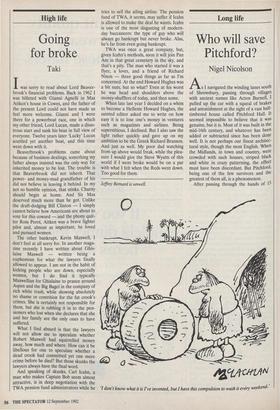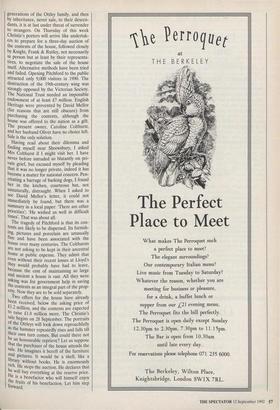Long life
Who will save Pitchford?
Nigel Nicolson
As I navigated the winding lanes south of Shrewsbury, passing through villages with ancient names like Acton Burnell, I pulled up the car with a squeal of brakes and astonishment at the sight of a vast half- timbered house called Pitchford Hall. It seemed impossible to believe that it was genuine, but it is. Most of it was built in the mid-16th century, and whatever has been added or subtracted since has been done well. It is not perhaps our finest architec- tural style, though the most English. When the Midlands, in town and country, were crowded with such houses, striped black and white in crazy patterning, the effect must have been discordant. But Pitchford, being one of the few survivors and the greatest of them all, is a phenomenon.
After passing through the hands of 13 'I don't know what it is I've invented, but! have this compulsion to wash it every weekend.'
generations of the Ottley family, and then by inheritance, never sale, to their descen- dants, it is at last under threat of surrender to strangers. On Thursday of this week Christie's porters will arrive like undertak- ers to prepare for a three-day auction of the contents of the house, followed closely by Knight, Frank & Rutley, not necessarily in person but at least by their representa- tives, to negotiate the sale of the house itself. Alternative methods have been tried and failed. Opening Pitchford to the public attracted only 9,000 visitors in 1990. The destruction of the 19th-century wing was strongly opposed by the Victorian Society. The National Trust needed an impossible endowment of at least £7 million. English Heritage were prevented by David Mellor (for reasons that are still obscure) from Purchasing the contents, although the house was offered to the nation as a gift. The present owner, Caroline Colthurst, and her husband Oliver have no choice left. Sale is the only solution. Having read about their dilemma and finding myself near Shrewsbury, I asked Mrs Colthurst if I might visit her. I have never before intruded so blatantly on pri- vate grief, but excused myself by pleading that it was no longer private, indeed it has become a matter for national concern. Pen- etrating a barrage of barking dogs, I found her in the kitchen, courteous but, not unnaturally, distraught. When I asked to see David Mellor's letter, it could not immediately be found, but there was a summary in a local paper: 'There are other priorities'; 'He wished us well in difficult times'. That was about all.
The tragedy of Pitchford is that its con- tents are likely to be dispersed. Its furnish- g, pictures and porcelain are unusually fine and have been associated with the house over many centuries. The Colthursts are not asking to be kept in their ancestral home at public expense. They admit that even without their recent losses at Lloyd's they would probably have had to leave, because the cost of maintaining so large and ancient a house is vast. All they were asking was for government help in saving the contents as an integral part of the prop- erty. Now they are to be sold separately. Two offers for the house have already been received, below the asking price of £1.2 million, and the contents are expected to raise £1.8 million more. The Christie's sale begins on 28 September. The portraits of the Ottleys will look down reproachfully as the hammer repeatedly rises and falls till their own turn comes. But could there not be an honourable reprieve? Let us suppose that the purchaser of the house attends the sale. He imagines it bereft of the furniture and pictures. It would be a shell, like a library without books. He is enormously Itch. He stops the auction. He declares that
he will buy everything at the reserve price. e is a benefactor who will himself enjoy the fruits of his benefaction. Let him step forward.



































































 Previous page
Previous page